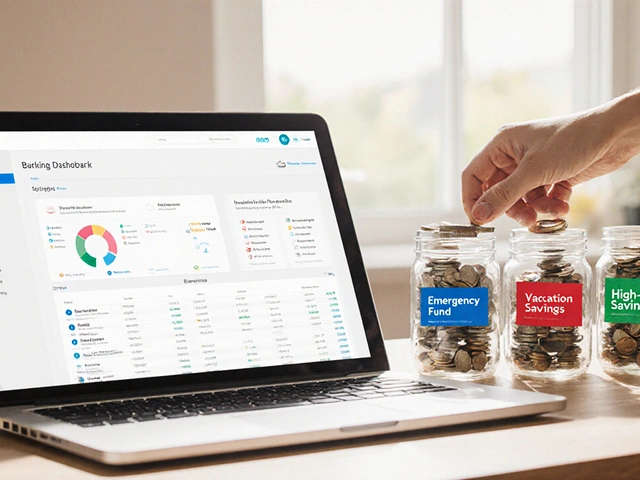
There’s nothing quite as exhilarating—and nerve-wracking—as taking a bet on your own business. The right idea, the right team, but then comes the thing that often trips up even the best: cash. In India, nearly 67% of small firms say getting a business loan is more stressful than pitching to investors. It's surprising, since India’s loan market is packed with options, yet entrepreneurs still struggle to choose what fits best. Not all business loans are made equal though, and a little inside knowledge could make the difference between building an empire and running out of gas just as you’re picking up speed.
Types of Business Loans in India
When someone mentions a business loan in India, it's easy to picture walking into a bank, filling out chunky forms, then bracing for weeks of silence. But the landscape has shifted a lot since those days. Now, lenders, from traditional banks to new-age fintech startups, dish out a large buffet of loan types—each with its mix of rules, perks, and downsides.
The most classic option is the Term Loan. This is what people typically mean when they say, “I got a business loan from the bank.” It’s straightforward: you borrow a lump sum, pay it off over a set period (say, three to five years) with a fixed or floating interest rate. Public sector banks in India usually offer interest rates starting at around 8% per annum for these. Some private lenders and fintechs can stretch this up to 24%, especially for unsecured loans. Secured term loans (backed by property, for example) attract lower rates. These loans suit those looking to buy machinery, expand operations, or even buy out a competitor. According to RBI reports, over 65% of Indian MSMEs still lean towards term loans, mainly for stability and predictable repayment.
Then there’s the Working Capital Loan. Not all businesses need a big lump sum; many just struggle with monthly cash flow swings—especially trading, retail, or seasonal businesses. Working capital loans help you pay suppliers, manage your inventory, bankroll day-to-day costs, or fill the gaps during off-season slumps. The tenure here is usually shorter (sometimes less than a year), and interest rates can be higher—think 12-20%. Still, for many small shop owners or manufacturers, this is a lifesaver to keep things ticking between payments.
Entrepreneurs also have the option to try overdraft facilities or cash credit, which basically act like a revolving credit line. You use what you need, pay interest only on the used amount, and keep topping up as needed. Banks set a credit limit based on your collateral (like property or business stocks). ICICI Bank and HDFC Bank are top providers of such facilities, offering limits upwards of ₹50 lakh for established businesses.
And do not forget MSME-focused schemes. The Government of India has been on a mission to boost Micro, Small, and Medium Enterprises (MSMEs). Schemes like the Credit Guarantee Fund Trust for Micro and Small Enterprises (CGTMSE) let you take loans up to ₹2 crore without collateral. Siddhartha, a cloth merchant in Jaipur, expanded his fabric unit using a CGTMSE-backed loan—a move that would have cost him stacks of paperwork and property pledges just a decade ago. This is changing the ground reality for smaller, less asset-heavy businesses.
Invoice Discounting and Bill Financing are also picking up steam. If you’re tired of waiting months for clients to pay invoices, certain NBFCs (Non-Banking Financial Companies) let you borrow against those pending invoices. For example, a Pune-based logistics company routinely receives 90% of invoice value upfront, paying a small fee, and this keeps their trucks rolling even before clients pay up. It’s fast, and approval rates are generally higher because the invoice itself is a kind of security for the lender.
There’s so much more—from equipment loans to merchant cash advances (where repayments are linked to your card sales)—but above are the most approachable starting points for Indian businesses.
Comparing Popular Business Loan Providers
Caffeine-fueled founders will always argue about which lender gives the best deal. But the smart move is to compare leading providers side by side. India’s lenders aren’t just a sea of similar banks; differences in eligibility, speed, required paperwork, and extra freebies (like free business credit reports) can add up in surprising ways.
Business loan in India is a phrase that’ll get you thousands of Google results instantly—but not all are equal. State Bank of India (SBI), India’s largest public sector bank, remains a favorite for term and working capital loans due to its vast branch network and government backing. They often ask for detailed business plans and financials but offer competitive rates (starting around 8.5% per annum). HDFC Bank and ICICI Bank, both private giants, respond faster and often have lower documentation burdens for existing customers. But watch out: processing fees can be nearly double those at public banks.
Fintech lenders like Lendingkart, FlexiLoans, and Indifi have exploded onto the scene since 2017. Their primary pitch? Speed. Some approve and disburse loans under ₹20 lakh in just 48 hours, almost entirely online. This is popular with tech-savvy, younger founders who don’t want to play by traditional banking rules or who lack heavy collateral. But all that speed comes at a cost—interest rates can be punchy, hitting 20-30% annually. Also, not all fintech lenders are totally transparent about hidden charges or penalties for early closure. Always read the fine print.
If you’re registered under India’s Udyam system or have certificates under Start-up India, some lenders will offer special rates or skip certain fees. Women-led businesses also benefit from various schemes—Punjab National Bank’s Mahila Udyam Nidhi, for example, offers concessional loans exclusive to female entrepreneurs.
NBFCs sometimes provide more customized schemes for non-traditional businesses (think event management, short rental properties, or export firms), but again, interest rates vary wildly. Bajaj Finserv, Axis Bank, and Tata Capital are NBFC heavyweights offering unsecured loans up to ₹50 lakh with minimal paperwork—and some of the fastest turnaround times for repeat borrowers.
To keep it simple, here’s a comparison table of popular loan providers and their common terms as of 2025:
| Lender | Loan Amount | Interest Rate | Tenure | Processing Time | Special Features |
|---|---|---|---|---|---|
| SBI | ₹50,000–₹500 lakh | 8.5%–13% | 1–10 yrs | 7–15 days | Lowest rates, MSME schemes |
| ICICI Bank | ₹1 lakh–₹200 lakh | 11%–18% | 1–7 yrs | 3–7 days | Fast approval, overdraft |
| Lendingkart | ₹50,000–₹30 lakh | 16%–27% | 6–36 mths | 48 hrs–5 days | Online, no collateral |
| Bajaj Finserv | ₹1 lakh–₹50 lakh | 15%–25% | 1–5 yrs | 3–5 days | Flexible top-ups |
| Punjab Nat Bank | ₹50,000–₹500 lakh | 9%–14% | 1–7 yrs | 5–10 days | Women, MSME focus |
If immediate working capital is all that stands between you and new orders, consider fintech for speed. If you want larger sums or longer terms—and have the patience for a bit more paperwork—a bank or NBFC wins hands down on rates. Always check reviews or talk to founders who’ve borrowed before; hidden extras have a way of popping up.

Who Should Apply for Which Business Loan?
This is the question that chokes most would-be borrowers. The best loan is the one that matches your business’s current stage, cash flows, risk appetite, and how quickly you need funds. The type of collateral you have—or lack of it—plays a massive part too.
If you’re early stage, need smaller funding (below ₹20 lakh), and don’t have assets to pledge, look at unsecured business loans from fintechs or certain NBFCs. Makers of handmade soaps in Bangalore or social media agencies in Ahmedabad tend to click here—they’re often young, digital-forward, and need funds urgently. Yes, the rates are higher. But if your margins are strong and you’re strapped for time, paying a bit extra for convenience might make sense.
Those running more established businesses with predictable revenues—like established traders, restaurants, or B2B service firms—should consider working capital loans or overdraft facilities from their regular bank. Here, a steady sales history works in your favor, and banks treat you to better rates or top-up eligibility over time.
If your biggest pain is waiting on client payments, invoice discounting or bill financing is a sleek way to unlock working cash without adding a traditional loan to your books. It’s perfect for exporters, wholesalers, and manufacturers with large, reliable buyers who just pay late per industry norms. Watch for the transaction fees, but this is big among businesses doing over ₹50 lakh a year in billing.
Now, if you have assets—a bit of gold, a commercial property, or even a healthy inventory—you unlock much better terms. Secured loans always have more reasonable interest, longer repayment periods, and higher ticket sizes. If the funds are for big CapEx (think new factory lines, advanced equipment, or facility upgrades), this is unarguably the smarter path. Banks also look kindly on applicants with a good CIBIL score (above 700 is the new sweet spot in 2025).
Women entrepreneurs, tribal entrepreneurs, or business owners from North-Eastern regions can unlock special, lower-rate government-backed loans under targeted MSME or ‘Stand Up India’ schemes. Take the time to check if you qualify—industry associations and local MSME facilitation centers can walk you through the process, often free of charge.
- If you’re in trade: Overdraft or short-term working capital is often enough.
- If you manufacture: Term loans or machinery loans get you a better deal, especially with government subsidies for certain textile, pharma, or electronics sectors.
- If you’re brand new or digital-only: Unsecured business loans from NBFCs or fintechs cut the chase—just mind the rates.
- For exporters: Bill discounting, export-specific loans, and forex-inclusive credit lines protect you from both payment delays and currency swings.
- For women/tribal/SC/ST owners: Check with banks for targeted products with lighter eligibility screens.
Don’t forget: Always compare total cost. Beyond interest rates, add up processing fees (typically 1-3% of loan amount), documentation charges, insurance (sometimes bundled), foreclosure penalties, and GST on fees. This stuff adds up quickly—a 1% fee on a ₹50 lakh loan is ₹50,000 off your principal just for the paperwork.
Tips and Common Pitfalls While Applying for a Business Loan
You can tick all the right boxes on paper and still have your loan rejected. It happens all the time. Why? Lenders care just as much about your story and paperwork as about your credit score. Here’s how to boost your chances and avoid nasty surprises.
- Document everything. Banks want to see at least two years of income tax returns, GST filings, and recent financials. Scan, upload, and organize these neatly—messy paperwork is the fastest way to get your file stuck in limbo.
- Keep your credit score clean. A few late payments—on credit cards, home loans, even your Netflix subscription—can drag your business’s risk score down. CIBIL scores above 700 are almost mandatory for good deals in mid-2025. Check yours for errors before applying; sometimes, old loans drag your score down by mistake.
- Be honest about your numbers. Loan officers aren’t dumb. If your stated cashflow looks way different from bank transactions, or if your GST numbers are much lower than what you’ve declared, expect questions—or delays.
- No big recent loan rejections. Loan application rejections show up in your credit report. Too many in a short span make you look desperate. Apply only after making sure you fit the criteria.
- Compare, don’t just settle. Approvals may be easy with fintech, but don’t ignore hidden costs or aggressive collection practices. Traditional banks can be slow but are often more lenient long-term if you hit a rough patch.
- Always double-check the moratorium period (the relaxation period before you have to start repaying). Longer moratoriums help if your project’s still ramping up and not yet generating revenue.
- Plan for rate hikes. Floating rates can climb sharply if the central bank ups its repo rate, as happened last in 2023-24. Fixed rates lock in predictability, though banks often nudge you toward floating because it’s riskier for them.
- Use a business PAN. Applying through personal PAN invites confusion on your credit report and can limit the size of future loans or confuse your business’s audit trail.
- Don’t skip insurance. Many banks bundle “key man” insurance or business asset insurance into your loan offer. While sometimes it feels like a forced add-on, it can actually protect your family or co-founders if something goes wrong.
- Watch out for scams. As loan-related digital scams have surged 20% since 2020, only apply through trusted portals or directly through your bank/NBFC’s official website. Never pay processing fees upfront to unknown agents.
If you’re planning a loan today, check if you qualify for the Mudra Loan (for micro units), CGTMSE (for zero-collateral), SIDBI schemes (for manufacturing or export focus), or NABARD rural enterprise schemes. Government-backed platforms now process more than ₹5 lakh crore in business loans yearly—much of it accessible online through a transparent portal.
Quick tip for first-timers: With digital onboarding, get your GST registration and Udyam/MSME certificate ready. For many banks, this short-circuits a bunch of eligibility checks and even fetches you better rates or approval chances.
No matter which way you look at it, the Indian market right now favors those who do a bit of homework—and know exactly why they need the funds. Pick the path that matches your business’s character and your appetite for paperwork, and you’re halfway there to building something that outlasts everything the banks can throw at you.








Write a comment